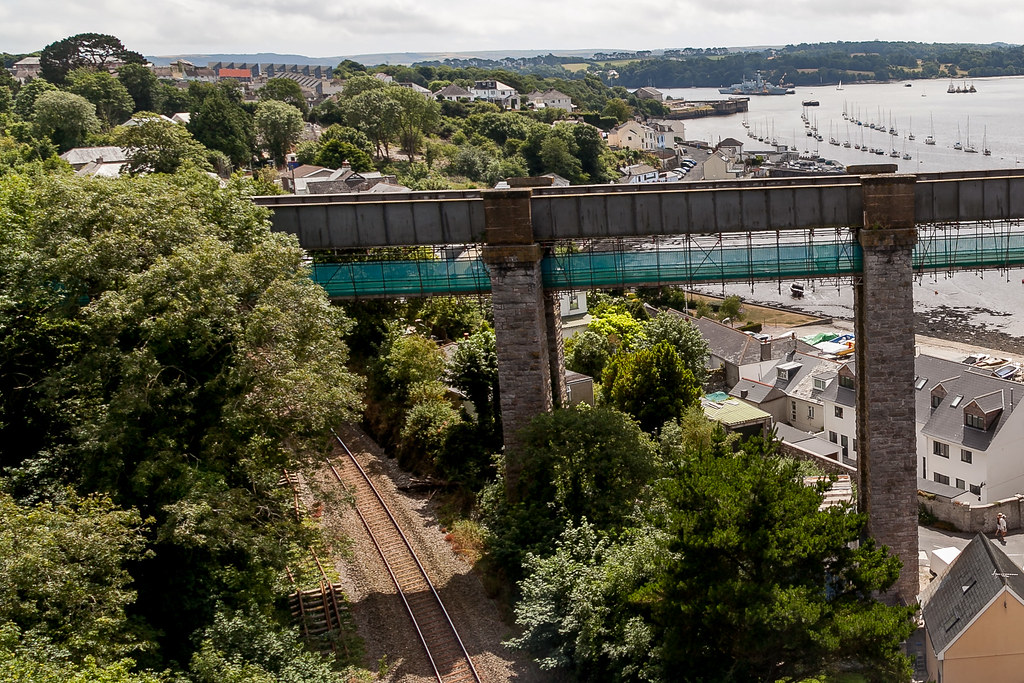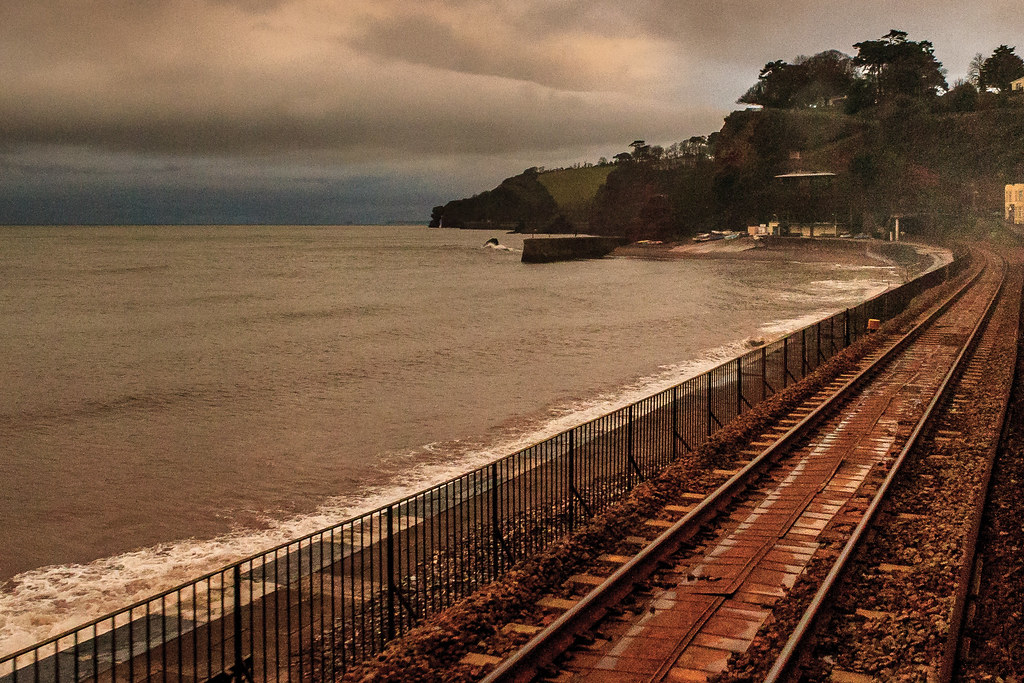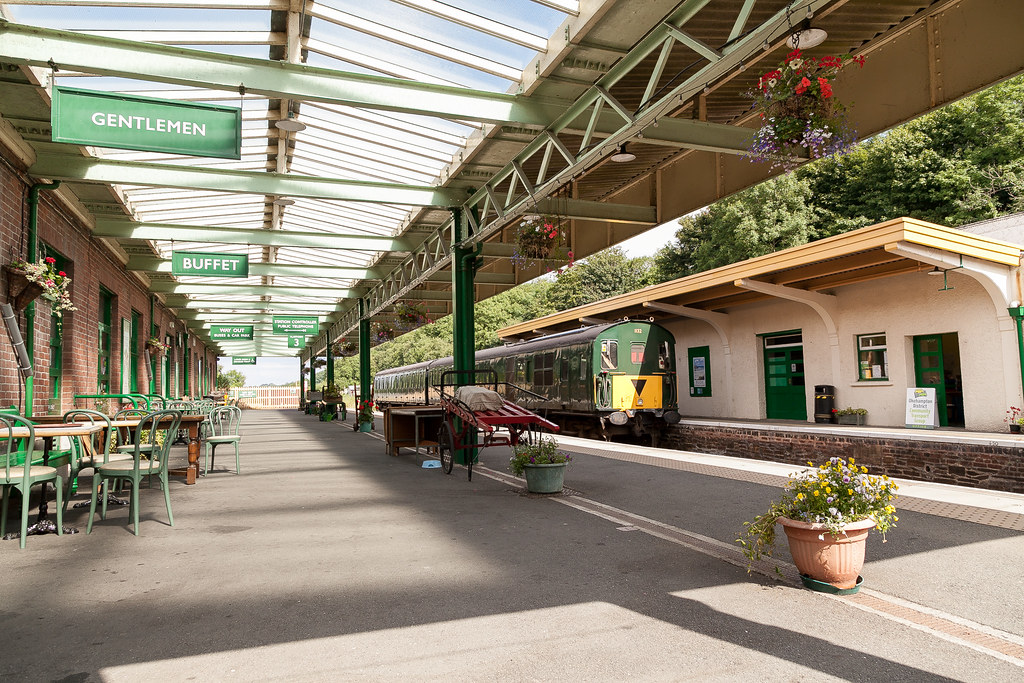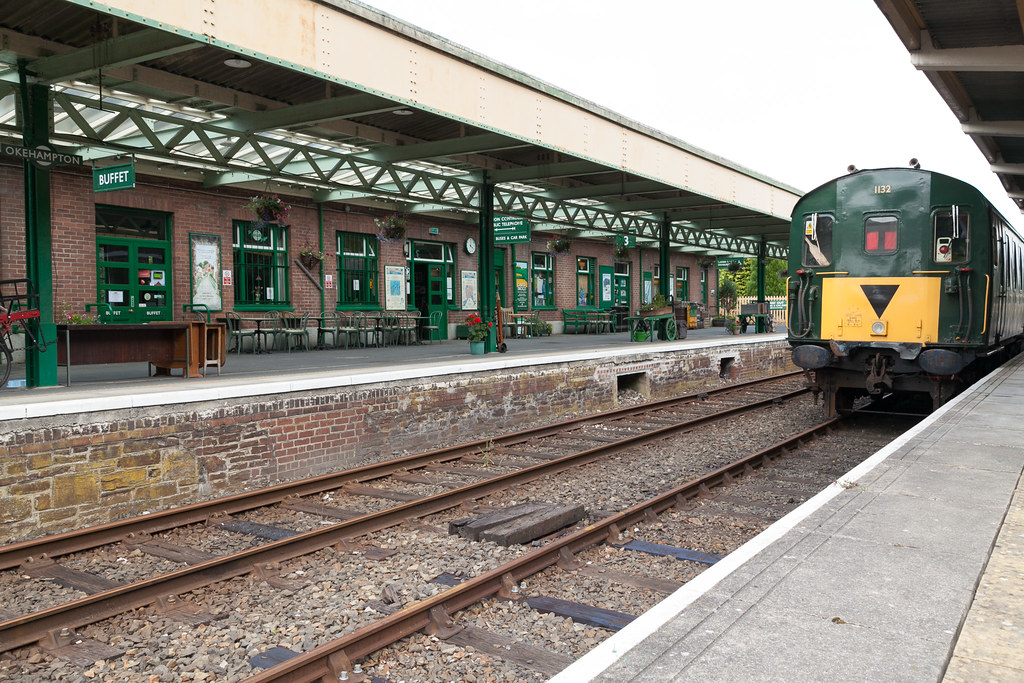
Reopen the Plymouth to Okehampton railway line
The horrendous storm that severed the main line between London and Cornwall today in Dawlish has illustrated the folly of closing a line some 50 years ago that could have served as a diversion.
The picturesque stretch of line between Dawlish Warren and Teignmouth is certainly picturesque:
Even so, it is the single point of failure in the West of England rail network. And today it failed in spectacular fashion. Raging seas demolished the substantial sea wall, washing away all the ballast and leaving both tracks suspended in mid-air.
Although Network Rail has pledged to rebuild the sea wall and reinstate the line, it will take several weeks and cost millions, both directly in repairs and indirectly in disruption to businesses in the region.
Until the late 1960s, an alternative route existed from Plymouth to Exeter via Tavistock and Okehampton. Both ends of this line are still in place.

The old Southern line to Exeter curving beneath the outer spans of Brunel’s Tamar Bridge to Cornwall.
But the central section – about 20 miles – is missing. This was closed as part of the infamous Beeching cuts. There are already plans to re-open the southern section, from Bere Alston to Tavistock. It is now time to extend the logic and restore this severed artery all the way back to the buffers at Meldon, west of Okehampton. The masthead photo for this post features Meldon Viaduct beneath a snow-capped Yes Tor. A key part of the route’s infrastructure is still in place, although probably no longer in useable condition.
Doing so would mean that bad weather can never again cut rail links from the South West to the rest of the country. It would also make the heart of this beautiful county more accessible to tourists. If the government can find anywhere between £40 bn and £70 bn to fund HS2, why not a less ambitious yet important scheme like this?
Updates:
10 February 2014 – according to the BBC on , this route is now actively being considered by Network Rail in preference to the other alternative to the Dawlish line, via Heathfield.
29 November 2017 – possibility of reopening various rail routes floated once again by the government. This route has once again appeared in maps published online by various newspapers.
10 February 2020 – Network Rail is currently inviting responses via a public consultation on its proposal to re-align the track between Teignmouth and Parson’s Tunnel to improve the resilience of the route.
Moving on from this proposal, I have also outlined five other rail projects that offer better value than HS2.
Does this make sense to you? Please leave your thoughts in the comments below.





Bev Osborne / February 7, 2014 /
I completely agree with you. I have been watching the current developments with interest and, yet again, can’t comprehend the short-sightedness of Dr Beeching’s axe wielding in the 1960s!
Dennis / February 8, 2014 /
This line should be re opened. Only 20 miles needs to be rebuilt although the rest of the line would need upgrading and resignalling for express passenger trains. The cost would be reasonable compared to many schemes.
Pingback: Five rail projects that offer better value than HS2
Alex Scott / February 10, 2014 /
In 2009 the cost of re-opening the section of railway from Meldon to Bere Alston was estimated at £100 million.
Even allowing for inflation and the usual cost over-runs, it seems reasonable to assume that for £300 million, the rail connection from Exeter to Plymouth via Okehampton and Tavistock could be re-established.
That looks like a very modest investment for a new transport link which would bring huge benefits to the Dartmoor region as well as greatly improving speed and reliability of passenger and freight services to Cornwall.
ray aguilar / February 12, 2014 /
I agree dominic,the line from okehampton to Plymouth should reopen,after the problems at Dawlish,also the lewes to uckfield line.much cheaper than hs 2.ray
James Hawkins / February 24, 2014 /
Good call, Dominic. Many of us have been fighting this fight for ages. Am sure you are aware that there is an e-petition to no 10 running at http://epetitions.direct.gov.uk/petitions/60302
Actually there have been several petitions in the past and there is at least another running concurrently. I’ve shared in FB another places and had some success in boosting numbers.
Time to invest in a niche bistro near Lydford Junction, methinks….. 🙂
Dominic / February 24, 2014 /
Sounds a very good idea on both counts!
Pingback: The Dartmoor railway question revisited
harry worth / November 16, 2015 /
fully support your call for oakhampton tavistock plymouth reopening .But what happened its all gone quiet .or is network rail waiting for another dawlish wash out
Dominic / November 17, 2015 /
You’re right. It has gone quiet again. More disruption this winter would certainly strengthen the case. It’ll be interesting, too, to see how successful the reopening of part of the Waverley Line in Scotland has been.
Mary C. Rhind / April 12, 2016 /
I would hope to achieve the line reopening with the help of the business lobbying groups ie Fsb ( federation of small business). working closely with Devon. It’s in all our interests to have an alternative route for the betterment of Devon and Cornwall. I do not mind my email being known to those who wish to support progress, indeed I wou;d be pleased to add your thoughts to our government lobbyists.
Chris Price / April 15, 2017 /
I agree with all the above. Now is the time for reopening the Plymouth line via Okehampton. So time to support the epetition.
pip / November 29, 2017 /
just look at the places the rail network could serve ie okehampton Tavistock Sanford courtney ,meldon , brentor only approx. 10 miles from Launceston mary Tavy we all know if trains ran to Tavistock they would be full into Plymouth at peak times okehampton to Exeter would have a few to also connections for north cornwall/ devon ie bude
jack c / April 22, 2018 /
Reopen the line fully
IAN HARRINGTON / April 25, 2019 /
This Line must be re-opened before the County Council allow more housing on land adjacent to the line as it enters Tavistock we are in danger of allowing the complete saturation of all land around Tavistock by housing development without leaving any space for a single platform from the Bere Alston Junction in the Tavistock Town as the Old southern Station site has been built on after the silly Town council built their offices on part of the station throat and allowed Housing on the end of the viaduct what silly short term thinking when all the time traffic on the only main road in and aout of the town A386 is completely at a standstill in the mornings and evenings with pollution from cars being breathed in by children as they walk to school
why or why cant the stupid DCC see this and act upon it by safeguarding the rail route from the Bere Aston section instead of allowing House builders to carry on without a penny being given to allow this 5 mile section to re-opened its time to say no more houses with out a proper consultation on the rail route
Steve freeman / April 30, 2019 /
I just don’t believe this will happen I’ve been watching this for a long time the government and network rail keeps promising that this will happen and then backtracking, now I believe this cost has risen quite substantially I just think it’s a no go same really as it needs to open now
Nigel Baldwin / May 1, 2019 /
Let’s think big for a change! A continuous railway along the south coast of England, from Penzance to Ashford (Kent) which would take in the ports of Exeter and Southampton. Think of the freight that could be taken off the roads.
Nick Moore / August 21, 2019 /
I have an even better idea, how about they build a new railway line which would incorporate some of the old lines from Taunton in the North East to Penzance in the South West.
This line could also take its name from a famous line from the past The Atlantic Coast Express or (ACE).
It would run from Taunton in the North East to Penzance in the South West via South Molton, Barnstaple (with a possible branch line to Ilfracombe) around to Bideford on to Torrington, Hatherleigh, Holsworthy, Bude/Stratton, Marhamchurch, Poundstock, Wainhouse Corner, Otterham Station, Camelford (serving both Boscastle and Tintagel), Wadebridge, St Columb then rejoining the old mainline at Quintrell Downs and running on to Perranporth to eventually rejoin the current mainline just South of Chacewater and on to Penzance.
Just a thought but it would still be miles cheaper than HS2 and it would serve a much better purpose reconnecting towns that should have never been severed by the Beeching cuts of the sixties and a lot of these towns have far bigger population figures than they did back in the sixties so it would make economic sense and would be commercially viable as well.
I would be interested to hear anybody’s thoughts on this, so what do you think???
Nick
Paul Dawkins / February 4, 2020 /
Teignmouth to Parson’s tunnel reconstruction
It has only recently come to my attention that Network Rail is considering a major reconstruction of the sea wall between Teignmouth and Parson’s Tunnel as a means of mitigating the possibility of a major land slip of the cliffs in the area. Following the collapse of the sea wall at Dawlish in February 2014, Network Rail was instructed to undertake its “West of Exeter Route Resilience Study”. The study examined the possibility of reinstating or creating alternative routes between Plymouth and Exeter. Have the findings of that study been re-examined (in the light of further evidence of the effects of Climate Change becoming apparent) and compared with the feasibility and cost of the current proposal?
The estimate for the reinstatement of the Bere Alston to Oakhampton was reported at circa £850m in 2014. This figure included a 66% contingency. How does this compare with the estimate of the cost of building the proposal for Teignmouth? I have been unable to find a figure for that.
There is an increasing need of providing alternative means of transport to the use of private motor vehicles whether they be petrol or diesel driven or electric. Re-establishing the Plymouth-Oakhampton route would surely bring multiple strategic, financial, economic and social benefits to that corridor. I find it hard to believe that the BCR for Route A (i.e. Bere Alston to Oakhampton) was assessed at a ridiculously low level of 0.14. This is a figure which is eminently challengeable I would suggest, especially if strategic factors are taken into account properly. An issue, which is rarely taken into account, is the extra over cost of undertaking work on an operational railway. What would the cost of the proposal at Teignmouth be if, prior to the works being undertaken, a permanent diversionary route had been established so that work on the sea wall could be undertaken either during planned favourable conditions or as a response to a disruptive land slide, which incidentally may not happen for years to come?
The political, social and economic climate have changed since 2014. Cornwall’s population is expanding thus increasing its dependence on the railway’s link to the rest of the UK. An alternative route with diversionary potential would bring instant benefits to the South West. Once re-established management and maintenance of the whole of the coastal section of the Great Western Mainline would become much easier and probably avoid the need altogether for the current proposal which requires creating new infrastructure in a very hostile environment.
Dr M D Brown / February 10, 2020 /
This is what I sent to my MP and to the consultation about the proposed Dawlish section rebuild:-
I am very concerned by the proposed plans to “improve” the railway line in the Dawlish and Teignmouth area. There is no doubt that this section of the rail line is vulnerable to damage by the sea as clearly demonstrated by the catastrophic collapse in February 2014. However, I consider the proposals for “improving the resilience” of this line are totally unrealistic and inappropriate for the following reasons:-
1) It is stated that the development will last for 100 years – RUBBISH! It will be underwater! See the scientific evidence relating to global warming and sea level rise below.
2) The public consultation involves presentations in Dawlish Warren, Teignmouth, Newton Abbot, Holcombe, Torquay and Exeter. I would like to point out that the railway line West of Exeter serves a far larger area than that! Penzance is the last sation West on that line and the rest of Cornwall and Devon use that line for travel to other parts of the UK. The railway line is vital infrastructure for the South West. To restrict public consultation on this project to a very local area is totally inappropriate and a much wider consultation is needed.
3) The proposed scheme would cause a serious loss of public beach in Dawlish Warren and Teignmouth which is currently used by the local population and huge numbers of summer tourists. Whilst I am aware that the beach will vanish under the sea anyway in the medium term, what is the point of spending large sums of money on a coastal railway line which is doomed to desctruction within a few decades? Let people enjoy the beaches while they can and let the railway planners focus their efforts and resources into a sustainable plan for an INLAND route West of Exeter.
4) Considering the many tens of billions of pounds that HM government is proposing to spend on the HS2 project, an inland route extension would be small beer in comparison. A new line from Exeter to Newton Abbot would need to be created and the existing line from Exeter to Okehampton reopened to serve North Devon.
GLOBAL WARMING SCIENTIFIC RESULTS (UK Meteorological Office and other sources):-
By 2070 the average summer temperature in the UK could increase by as much as 5.4 degrees in summer and 4.2 degrees in winter (source – “UKCP18” ie United Kingdom Climate Projections 2018). The frequency of hot spells is also on the increase with the UK’s highest recorded temperature occurring in 2019.
Temperatures in the Antarctic have been shown to be increasing more rapidly than other places on the planet, inevitably resulting in rapid melting of glaciers and sea ice. Satellite and modelling evidence suggest that this collapse could already be underway, via a positive feedback known as ‘Marine Ice Sheet Instability’. The projected global rise in sea level is accelerating, resulting from (a) thermal expansion of seawater (b) melting of glaciers and ice sheets (c) land water storage. Sea level is predicted to rise by 1 metre by 2100 (UKCP18 Marine Report, November 2018) but other studies have predicted a rise of well over 2 metres!
Increasing temperatures are likely to cause melting of the permafrost in Arctic regions, potentially releasing vast quantities of methane into the atmosphere. Methane is 40 times more potent than carbon dioxide as a “greenhouse gas” and thus global warming would rapidly accelerate.
There will be a substantial increase in tidal and storm surges due to more intense storms from warmer seas. On 6th Dec 2013, due to a bad storm, tidal surges of up to 1.97 metres were observed in the UK. Combined with a potential rise in sea level of over 1 metre (or far more!), the 3 metre plus total would bring total devastation of large areas of coastal land.
These results show that continuation of a coastal route for the railway line West of Exeter is totally unrealistic – an INLAND ROUTE is the only medium and long term solution.
Rog Laker / August 5, 2020 /
Similar issues in East Sussex. Focus on Brighton Main Line Improvement Programme (Dawlish) means insufficient transport case for reinstating Lewes (Tavistock) to Uckfield (Okehampton). Once Tavistock is rail-connected to Plymouth (like Lewes already is to Brighton) and Okehampton has regular services to Exeter (like Uckfield now has to London Bridge), and the primary route has been made more resilient, the case for linking the two places in each pair with a second route is harder to make. In each case there are very few people in between the two pairs of towns to be served by the reinstated line so any new intermediate stations also hard to justify. For Lewes-Uckfield, Brighton’s official Objectively-Assessed Unmet Housing Needs which cannot be accommodated within its own boundary would justify a new Garden Community somewhere in Lewes District between the two towns which would then be connected by a reinstated rail link. Where could a new Garden Community of at least 6k new homes (15k population the minimum for a line and station to be viable) be located between Tavistock and Okehampton and be served by the railway given the presence of the National Park? Lewes-Uckfield likewise has to avoid the South Downs National Park.
John M Caley / August 12, 2020 /
Of course the ex-LSWR line from Exeter to Plymouth should be re-opened as a matter of necessity. Just goes to show the shortsightedness of the Beeching axe era ; more interested in money, than serving the local community, and providing an alternative inland route from Exeter to Plymouth. A good eye opener from Rob Bell presenting Channel 5’s “Walking Britain’s Lost Railways” tonight Wednesday 12. 08. 2020 from 19:00 to 19:55.
Raymond Howlett / February 26, 2021 /
The reinstatement of the rail line from Exeter through Okehampton .
Will destroy the very reason tourists come to the area for walks and bike rides along the granite way and use the small businesses in the Town .
The old station is not fit for purpose ,to be used again as the main stop would cause caoctic traffic in the Town , Okehampton would be turned into a through Town again .
Just to add 20 mph. speed limit anywhere in the Town would be helpful.
brian george potter / December 31, 2022 /
When will the line between Tavistock and Okehampon reopen, not so long ago it was said that Meldon viaduct was no able to be use for trains
Dose joe public believe this section of line will reopen drem on folks